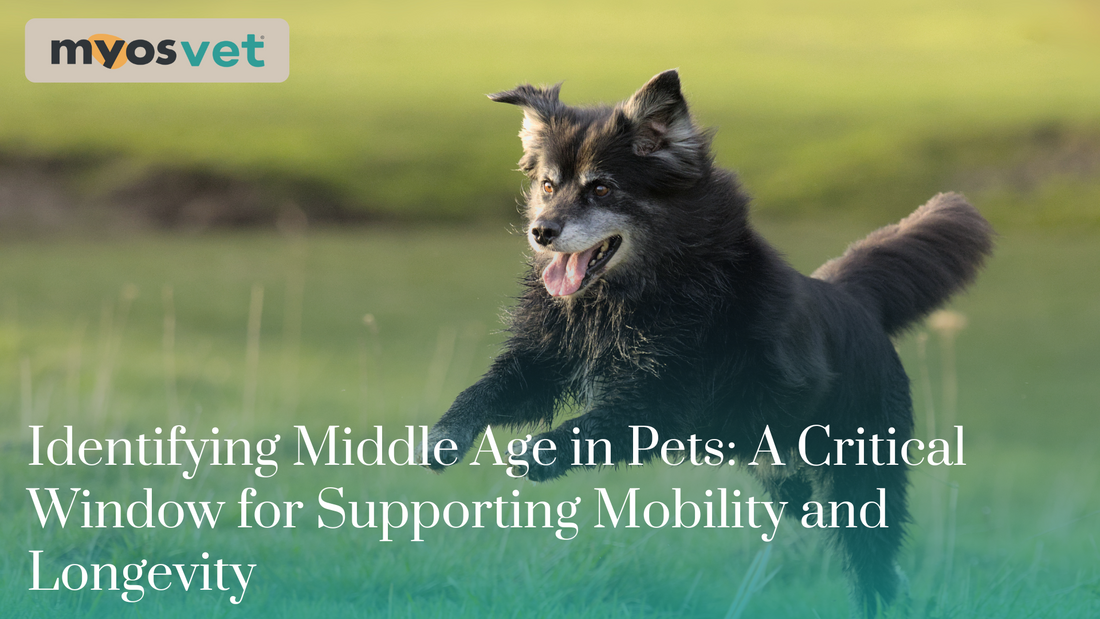
Identifying Middle Age in Pets: A Critical Window for Supporting Mobility and Longevity
Share
As veterinary professionals, we recognize that aging in our patients is a continuum rather than a sudden shift. One of the most important—but often overlooked—transitional phases is middle age. This period represents a crucial window of opportunity to identify subtle physiologic changes and implement proactive strategies that can help preserve both mobility and overall longevity.
Defining Middle Age in Dogs and Cats
Middle age is not defined by a single number, but rather by breed, size, and individual health status:
- Dogs: Small breeds may not be considered middle-aged until 7–8 years, while giant breeds can reach this stage as early as 4–5 years. Medium and large breeds generally fall somewhere in between (6–7 years).
- Cats: Cats are often considered middle-aged between 7–10 years, though individual variation in health and activity levels must be taken into account.
Veterinarians should assess each patient individually, considering factors such as body condition, prior injuries, genetic predispositions, and lifestyle.
The Subtle Signs of Transition
During middle age, musculoskeletal changes may begin to manifest subtly. Owners may report:
- Hesitation with jumping or climbing stairs
- Slight stiffness after exercise or rest
- Reduced enthusiasm for play or activity
- Gradual weight gain despite stable feeding routines
These early indicators are often dismissed as “normal aging,” but they may represent the earliest opportunities for intervention.
Why Early Intervention Matters
Once a patient reaches middle age, the cumulative effects of microtrauma, decreased muscle protein synthesis, and joint stress begin to accelerate. If left unaddressed, these changes can contribute to sarcopenia, decreased mobility, and secondary conditions such as osteoarthritis and obesity.
By addressing muscle health, weight management, and joint function proactively, veterinarians can meaningfully influence long-term quality of life. Middle age is the optimal time to transition from reactive to preventive care.
Strategies to Support Mobility and Longevity
- Nutritional Support: Incorporating high-quality protein and targeted nutritional interventions such as Fortetropin®—a natural, bioactive composition shown in multiple peer-reviewed studies to support muscle health—can help maintain muscle mass during this transitional phase.
- Joint and Connective Tissue Care: Ingredients such as green-lipped mussel and eggshell membrane can provide synergistic support for joint comfort and mobility.
- Weight Management: Close monitoring of body condition and tailored diet recommendations reduce stress on joints and delay the onset of mobility issues.
- Activity Modification: Encouraging regular, controlled exercise that balances strength-building with joint protection helps sustain mobility.
- Owner Education: Engaging pet owners in recognizing subtle changes and emphasizing proactive wellness care is essential to early success.
A Clinical Call to Action
Middle age represents the pivotal turning point in the health trajectory of our patients. By identifying this stage early and implementing targeted strategies, veterinarians can extend mobility, improve comfort, and ultimately enhance longevity. Supporting muscle health and joint integrity during this time is not just preventive medicine—it is proactive longevity care.
